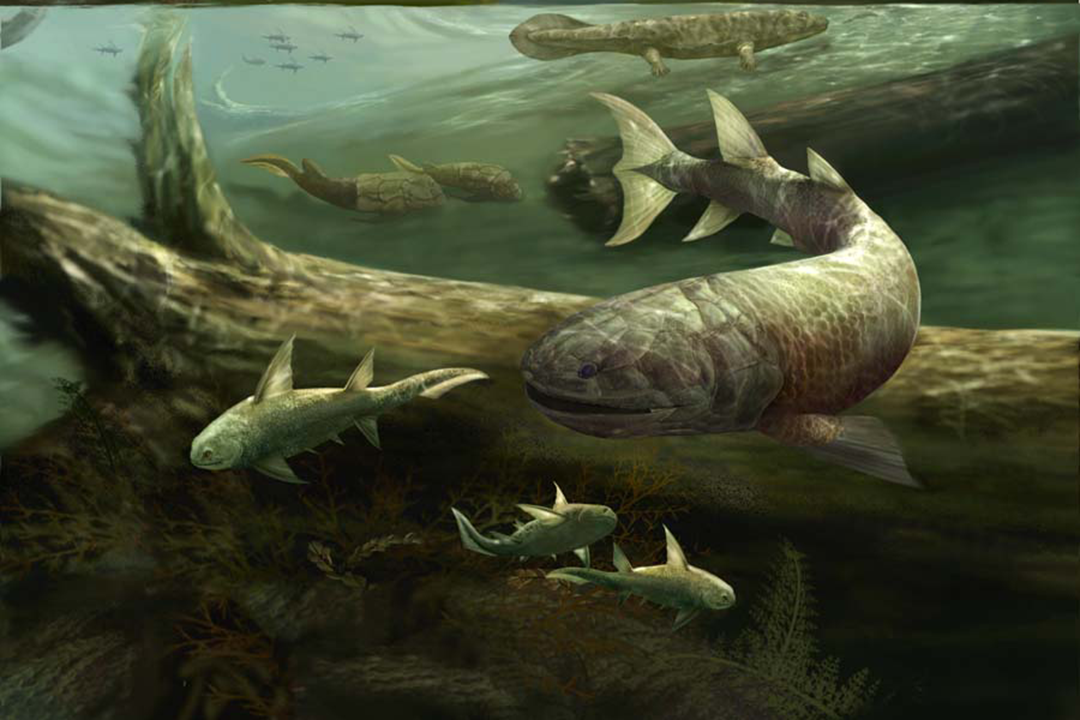In her Fins and Limbs Lab at the Columbian College of Arts and Sciences (CCAS), George Washington University Assistant Professor of Biology Sandy Kawano uncovers how our early ancestors took their first steps—or strokes or slithers—out of the sea and onto the land.
Using state-of-the-art technology like 3D imaging and machine learning, she explores how terrestrial locomotion evolved. Her work tests almost 400 million-year-old questions about what mechanical requirements are needed to walk on solid ground.
And now, thanks to a three-year, $1.4 million grant from the W.M. Keck Foundation, Kawano is expanding her research to encompass new species and earlier stages during the evolution from water to land. The planned outcome is a vast dataset—“Possibly the biggest yet for amphibious fishes,” Kawano said—that will detail the anatomical and physiological features enabling animals to move between drastically different environments.
Her work may reveal unique features of fish bones that allow them to be strong yet flexible while uncovering novel strategies for performing amphibious locomotion—a popular topic in technology such as bioinspired robotics.

“The Keck grant is going to allow my team to expand [our research] much further…by examining what enabled amphibious fishes to defy the odds and walk on land,” Kawano said.
Based in Los Angeles, the W. M. Keck Foundation was established in 1954 by the late W. M. Keck, founder of the Superior Oil Company. The foundation’s grant program is focused primarily on pioneering efforts in the areas of medical research and science and engineering. The foundation also supports undergraduate education and maintains a Southern California Grant Program that provides support for the Los Angeles community, with a special emphasis on children and youth.
Last year, Kawano received a $1.1 million grant through the Faculty Early Career Development Program (CAREER) from the National Science Foundation to support her research on the evolutionary biomechanics of salamander locomotion.
“Dr. Kawano’s pioneering and innovative work in this field is transforming our understanding of how certain species evolved, and shedding new light on the link between form and function,” said CCAS Dean Paul Wahlbeck. “I’m so appreciative of the Keck Foundation for enabling her to expand her important research.”
The water-to-land enigma
With the Keck grant, Kawano plans to extend her research beyond tetrapods (vertebrates with four limbs) to gain a better understanding of how our ancestors made the transition from water to land roughly 375 million years ago. Determining how vertebrates first moved onto land is central to understanding human anatomy, Kawano said. But it remains an enigma. Prehistoric fishes are theorized to have had bones too weak to crawl onto land, so the shift from fins to limbs may have been a necessary evolutionary innovation.
Fossil evidence now suggests that terrestrial walking may have occurred almost 50 million years before tetrapods originated. Living fishes can move on land without major terrestrial adaptations typical of tetrapods, potentially revealing alternative strategies for amphibious locomotion.
In her new work, Kawano will develop computational models that estimate the capabilities of extinct animals and decipher the novel features of fish bones that enable numerous living species to leave the water’s edge.
Using living salamanders and amphibious fishes as functional models of their extinct relatives, her research will incorporate fossil morphology from extinct fishes and tetrapods to help resolve long-standing debates about when and how vertebrates first moved onto land.

The project also integrates a variety of STEM techniques—such as physiology, 3D imaging, materials science and engineering and machine learning—to pioneer work on the functional diversity of bones. Unlike past research efforts, Kawano can now access ultra-sophisticated technology to collect data from micro-scale specimens, including bones just a millimeter in width.
Identifying the mechanistic links between form and function has broad implications, Kawano said—from synthesizing biomaterials for NASA to working on adaptive exoskeletons through the Defense Advanced Research Projects Agency to designing amphibious robots for autonomous exploration of dangerous terrain.
“I am honored and incredibly grateful to the W.M. Keck Foundation for their generous support. With the Keck Research Grant, I will not only be able to reach new horizons in my career but also support the professional development of postdoctoral researchers, post-baccalaureate students and undergraduate students,” Kawano said.
In her lab and classroom, Kawano introduces students to the research possibilities of what she calls “nature’s misfits”—like climbing salamanders and fishes that live on land.
“These animals are a treasure trove,” she said. “My students ask me, ‘What do you think we’ll find?’ And I tell them no one knows. That’s the exciting thing. We are at the forefront of discovery.”


